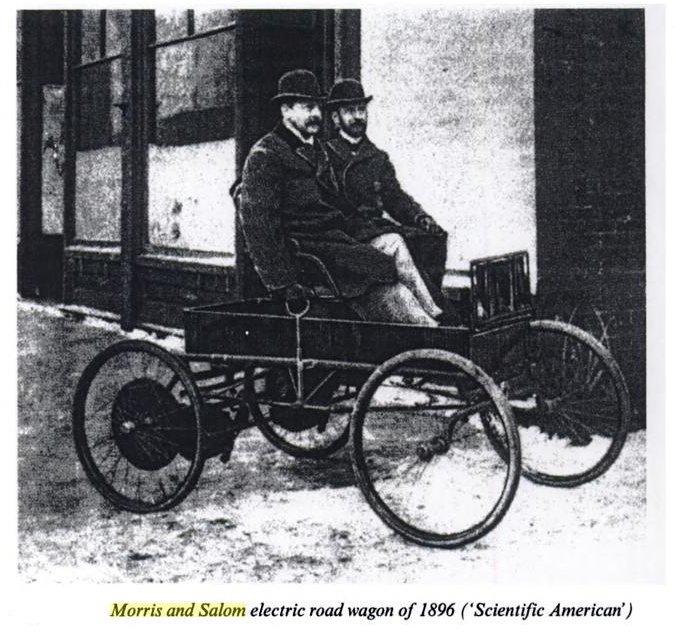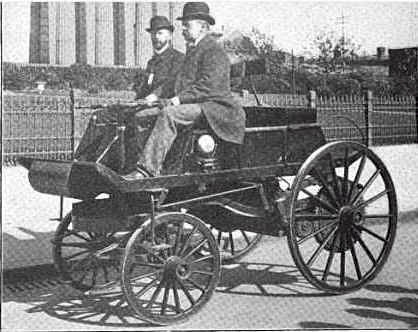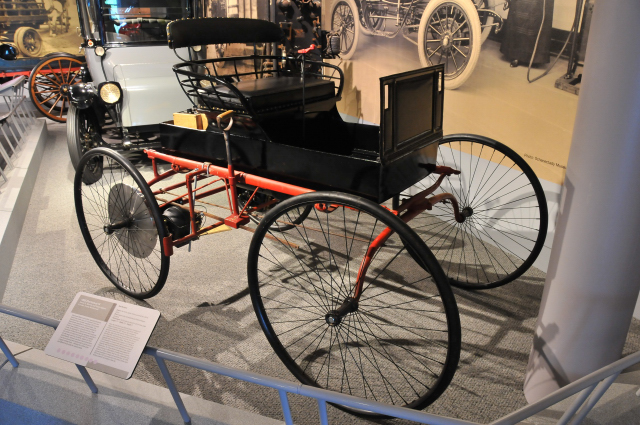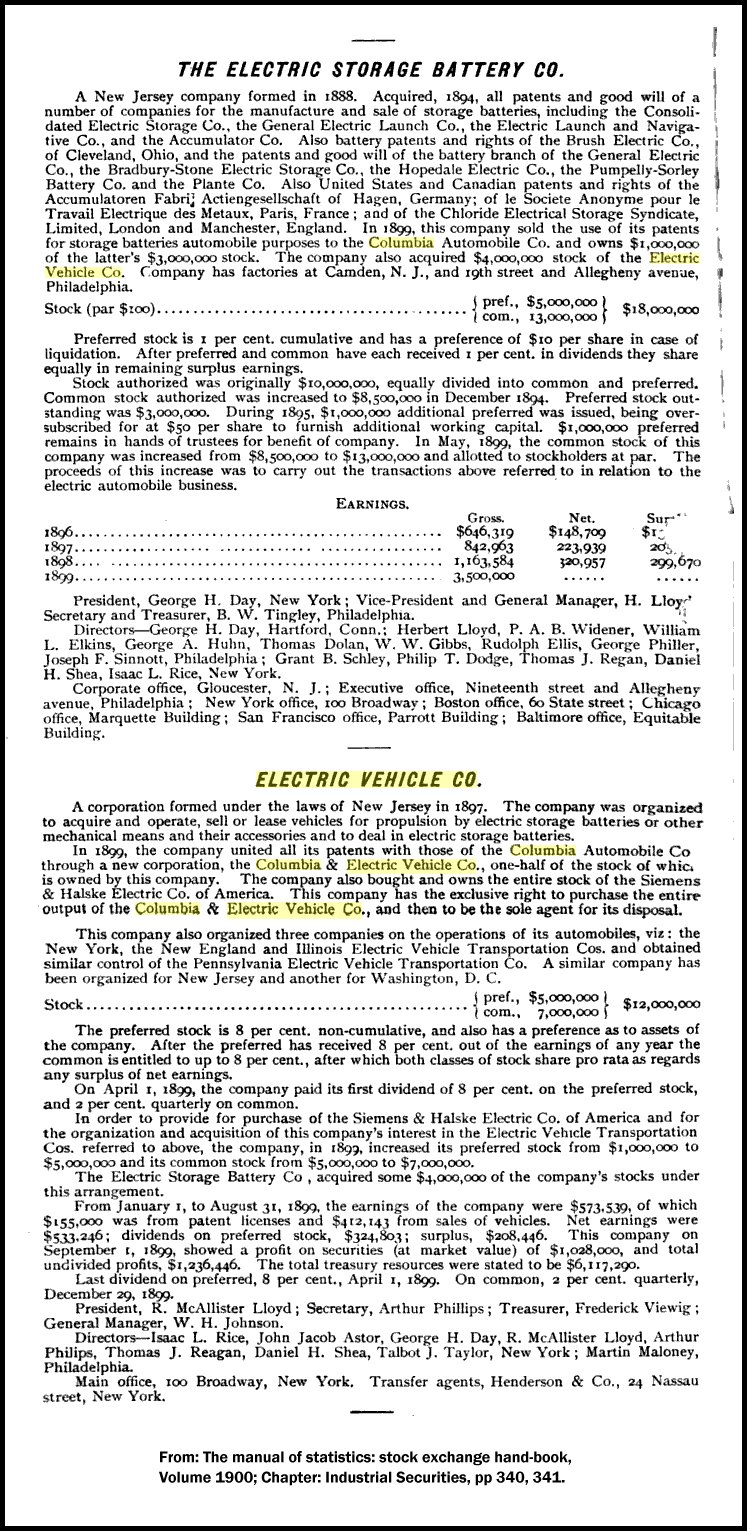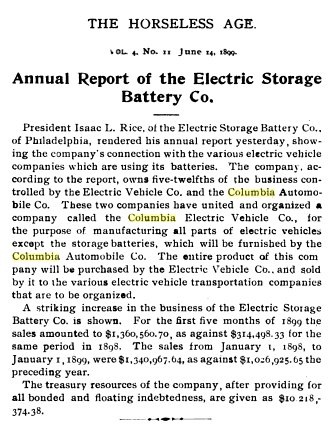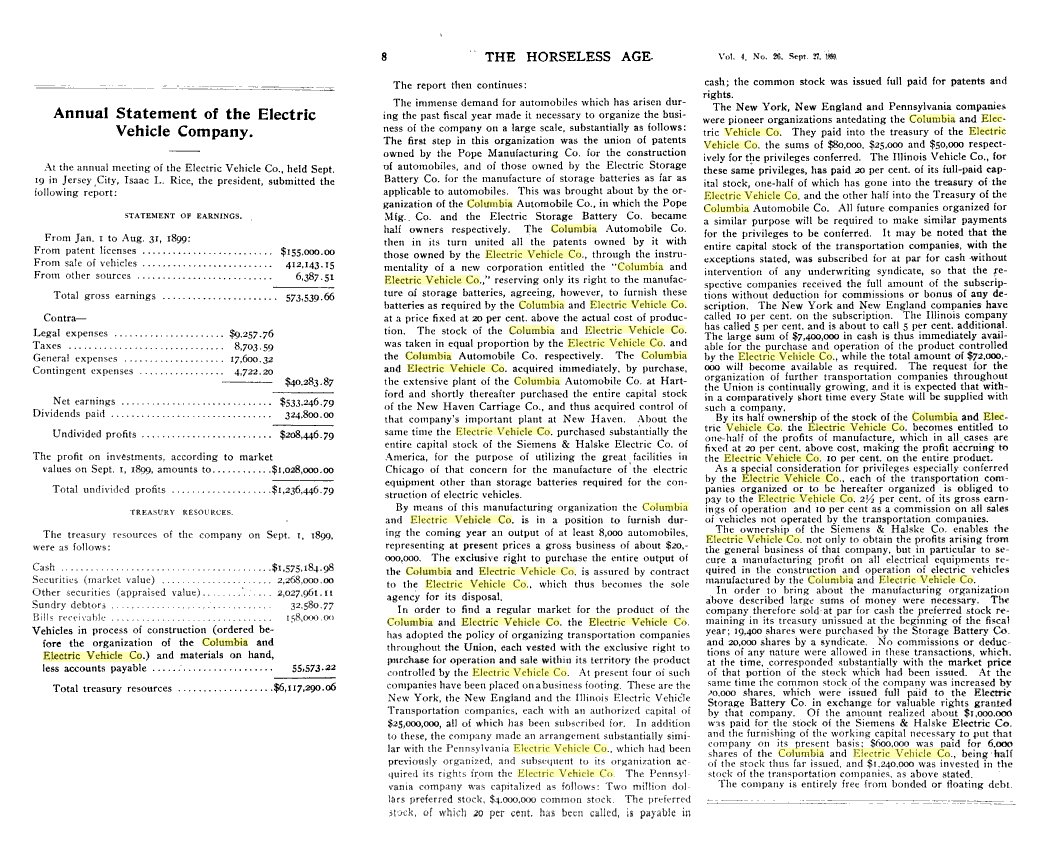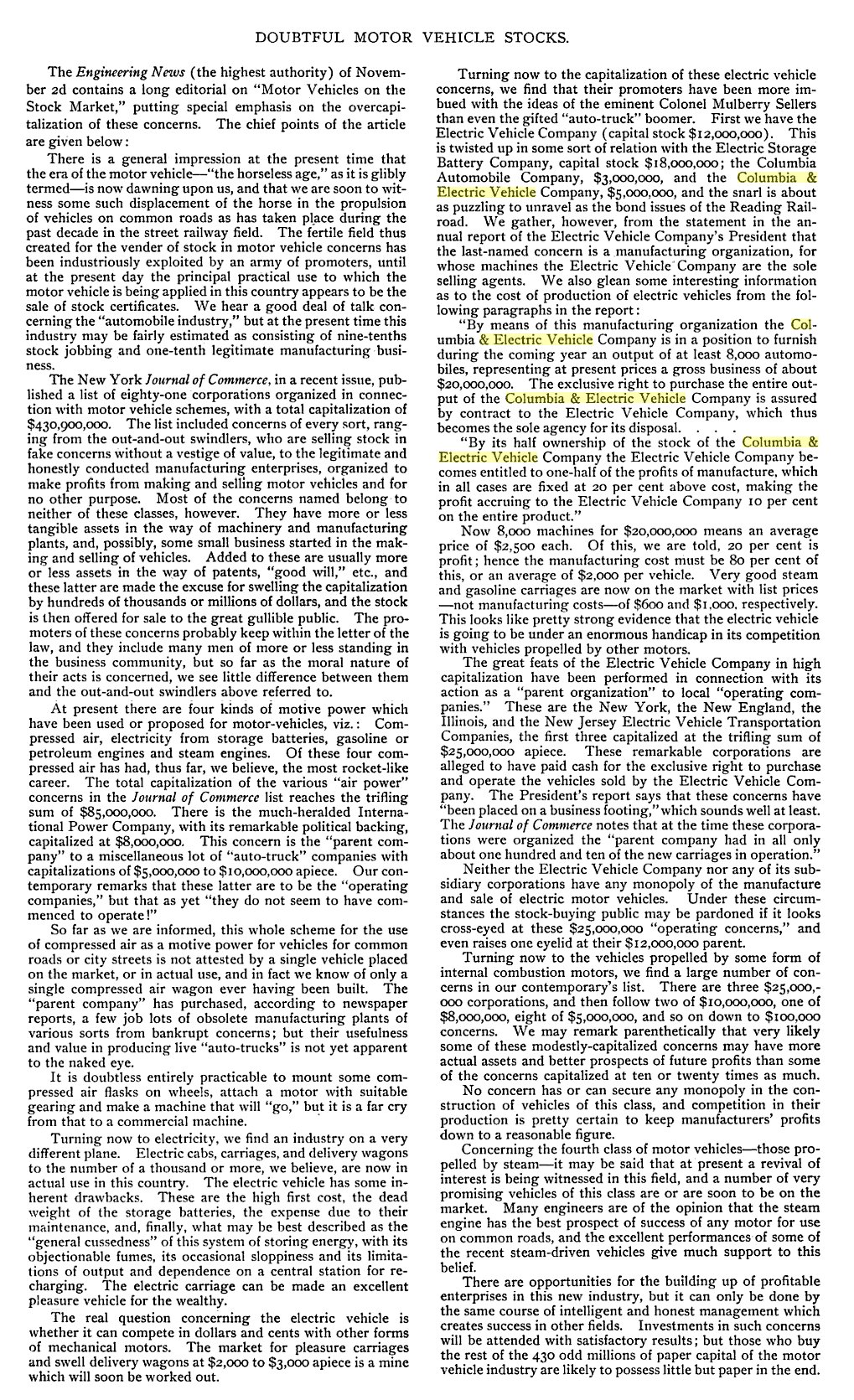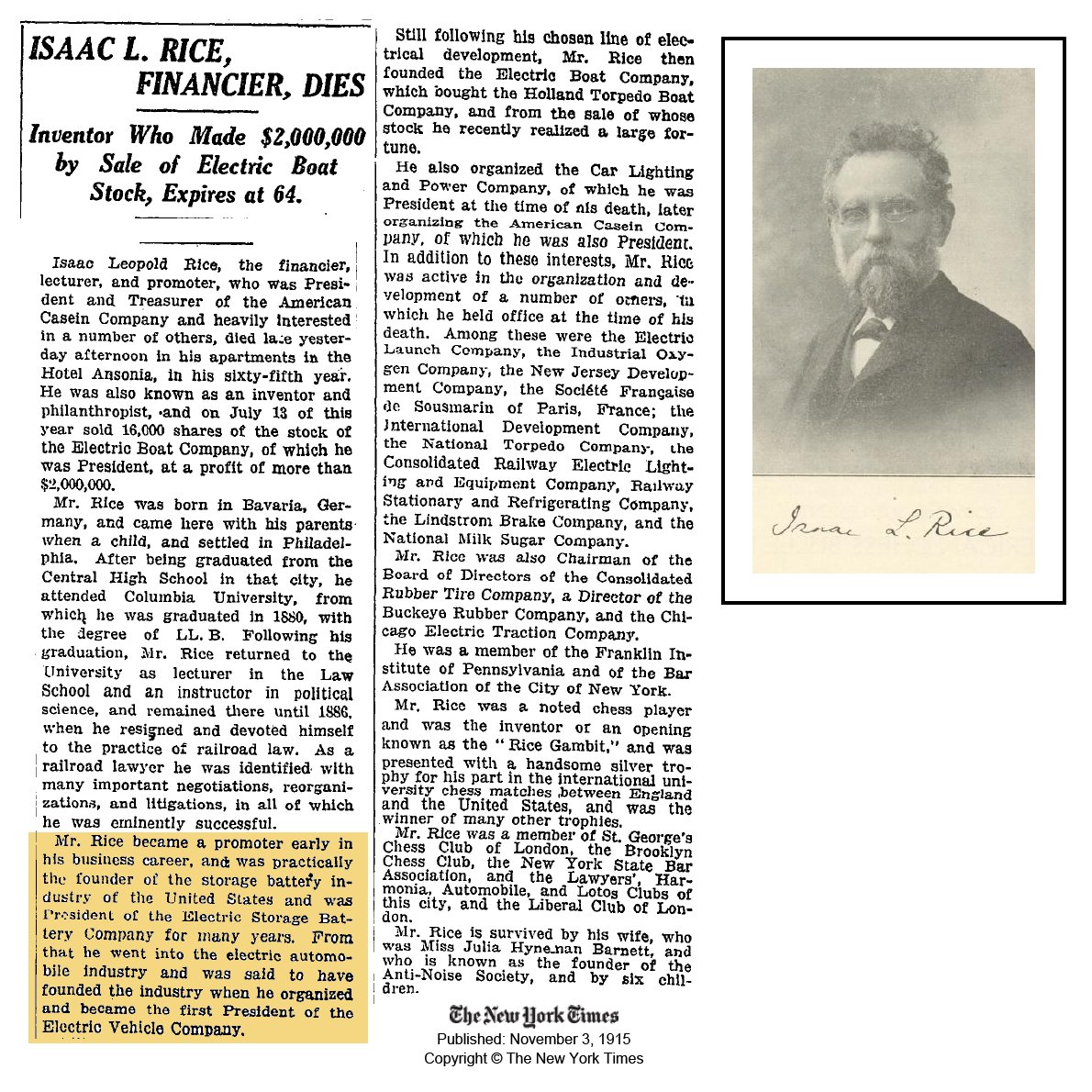Bringing Invention to the
Marketplace
By Joseph W. Slade
For Isaac
Leopold Rice, inventions and patents were pieces to be fitted together.
In creating ways to combine and sell them, he helped invent the modern
corporation.
Although no one could ever patent it,
one of
the most important inventions of the late nineteenth century was the
modern corporation, and of those who might lay claim to it, Isaac
Leopold Rice was perhaps the most brilliant. At his best, a corporate
entrepreneur like Rice was as much an innovator as was the inventor of
a practical machine or process, for he institutionalized the useful.
Rice was extraordinarily shrewd about patents, building more than
fifteen corporations to sell technologies devised by other men. His
astonishing versatility contrasted sharply with the single-mindedness
of many captains of industry, while his cultivated personality differed
just as strongly from the flamboyance of the Goulds and the Edisons.
Curiously reticent for one so talented, he gave his name only to a
now-forgotten gambit in chess, a particularly audacious sequence of
moves. Musicologist, lawyer, professor, writer, publisher, financier,
and founder of the companies that ultimately became General Dynamics,
Rice moved from career to career as if they were squares on the
beautiful inlaid chessboards he loved.
The Rice gambit called for a
calculated
sacrifice, and Rice himself often abandoned eminence in one field to
pursue it in another. In February 1893, as head of the financial
syndicate trying to rescue the Philadelphia and Reading Railroad, Rice
hastily returned to America when the company filed for bankruptcy. He
had been in London raising money on the line’s coal assets as part of
his scheme to reorganize the railroad and its mining ventures into the
elements of a corporate holding company. This strategynovel for its
day—was sabotaged when the company’s president borrowed still more
money for further expansion. Disgusted, Rice resigned his chairmanship
in May and over the next several months watched from the sidelines as a
new syndicate headed by J. P. Morgan stole Rice’s own reorganization
plan by forming the Reading Company.
Railroads have been called America’s
first
big business, but everywhere they lay in disarray, their weaknesses
exposed by the depression of 1893. Consolidation and reorganization of
the railroads was a glamorous enterprise in the late nineteenth
century, but the ailing giants required more money and influence than
Rice could mobilize. From his experience with railroads, however, he
had learned new techniques of organization, finance, management, and
competition, and the success of inventions during this crucial period
depended directly on the emergence of precisely those institutional
structures. It was no longer enough merely to invent a better
mousetrap, nor was it enough simply to back it. To be exploited
profitably, an invention had to be patented, developed, and perfected,
its manufacture assured, demand for it created, its virtues advertised,
and distribution systems put in place. The corporation evolved to meet
those diverse needs, and Isaac Rice used his corporations to transform
electrical, automotive, and naval novelties into familiar commercial
and social realities.
Inventions “might be called my ‘fad,’”
he
later said. At the time they seemed to be everybody’s. Since 1882, for
example, Americans had applied for patents on some three thousand
electrical inventions each year. Nearly all those gadgets seemed to be
on display at the Chicago exposition of 1893. Although the largest
crowds surged around the huge, humming dynamos, Rice noticed that most
of the exhibits demonstrated machines powered by batteries. Despite
their potential, the expensive dynamos performed erratically,
especially at times of peak demand. The much cheaper batteries were
heavy, corrosive, and leaky, but they stored the dynamo’s energy—as
“pickled amperes”—so that it could be delivered on demand for virtually
any purpose.
Rice also noticed at the exposition
that one
particular battery ran such diverse machines as Otis’s elevator, the
electric launches that glided around the midway’s lagoons, and Edison’s
new motion-picture cabinet, the Kinetoscope. That battery was the
chloride accumulator, manufactured by the Electric Storage Battery
Company of Philadelphia, where Rice had grown up. Built since 1888, the
accumulator incorporated Clement Payen’s idea for plates of fused lead
chloride and the principles of Charles Brush, the Cleveland electrical
pioneer. Designed for large capacity and rapid recharge, it was prized
by those who wanted dependable power. It was also enveloped in patent
chaos. Inexpert examiners in the overworked Patent Office could
scarcely distinguish one battery from another, and misinformed court
decisions had invited patent infringements and inflated claims by any
company that could coax current from an electrolyte. As Edison
remarked, “When a man gets on to accumulators his inherent capacity for
lying comes out.” Constantly attacking or being attacked, Electric
Storage Battery was close to ruin. The chloride accumulator needed an
entrepreneur.
Schooled in railroad and patent law,
Rice
established order by using the tools of monopoly and consolidation. He
distinguished between financial monopoly, which crippled competition,
and temporary patent monopoly, which encouraged not just a particular
industry but others as well. Too often, he wrote, gearing up a factory
could consume half the seventeen years of a patent’s life; if the
courts could not protect the inventor’s right to exploit his discovery
fully, then the entrepreneur would have to do it for him. To wield
monopoly as an instrument, however, he first had to acquire it.
Using his railroad profits, Rice
bought
enough shares of the Electric Storage Battery Company to acquire a
directorship. Then, acting as the firm’s attorney, he began buying
patents—more than five hundred. Some he bought to use, some to prevent
others from using them. He spent $250,000, a frightening sum for a
company whose gross receipts in 1894 were only $300,000. He reduced the
risk, however, by incorporating or buying what he called “cognate
industries”: the Consolidated Railway Electric Lighting and Equipment
Company, the Car Lighting and Power Company, the Railway and Stationary
Refrigerating Company, the Lindstrom Brake Company, and the Quaker City
Chemical Company. All these companies used storage batteries, and all
of them shared patents for electrical and chemical products, ranging
from refrigerators and axle generators to electrolytes. As president of
each company, he could consolidate them at will, just as he had
consolidated patents.
For all the apparent sleight of hand,
Rice’s
corporate approach was honest. He invited investors to join him in his
ventures but insisted that they risk their own capital. Remembering his
railroad defeats, he admitted to a “holy horror of debts, loans,
bonds.” He did not want the money of widows or orphans, nor would he
manipulate shares of stock. Rice encouraged investors to consider him
an inventor, and he was. By combining certain kinds of patents, he
invented a hybrid battery, the best in the world. By exploiting still
others, for containers, connections, frames, and switches, he invented
a market. In 1895 the Electric Storage Battery Company grossed a
million dollars from batteries designed to fit lathes, drill presses,
sewing machines, telephone and telegraph stations, switchboards, fans,
fire alarms, phonographs, hospital tools, automated pianos. Sixty years
later the firm could still claim that the Exide battery (a trade name
adopted in 1900) affected the life of every American every day.
Such entrepreneurial inventiveness
stimulates a whole economy. By removing the threat of litigation that
had retarded new applications, Rice nurtured two huge industries.
Massive lead cells between the bogies of trams became familiar to
millions of Americans as traction companies in Philadelphia, Chicago,
and New York switched from overhead trolleys to battery-powered mass
transit. More important, the Electric Storage Battery Company installed
giant arrays of batteries in the central power stations of dozens of
cities to safeguard the supply of electricity during peak hours, once
again to the benefit of millions. Noting these sales in 1896, The New York Times
announced that accumulators were profitable at last. By 1897, now
president of the company and long since a wealthy man, Rice had
achieved virtual monopoly over the manufacture of batteries in the
United States.
Rice was America’s most urbane, most
intellectual, and most unlikely industrial czar. As paradoxical as the
nervous, distinguished gentleman seemed to his business contemporaries,
however, he was merely an entrepreneur of his own passions; he just had
more of them than most people. Born in 1850 in Bavaria, Rice emigrated
with his parents to Philadelphia. Little is known of his youth there
until he graduated from Central High School. Sure of his artistic
inclination, his mother sent him to Paris to study music and
literature. To support himself, he became at eighteen the Paris
correspondent for the Philadelphia Evening
Bulletin.
He was an accomplished pianist and taught pupils first in London, then,
on his return to the United States in 1869, in New York. For almost a
decade he taught music and languages and wrote for newspapers. In 1875
he published What Is Music?, a book on
theory, following it in 1880 with a second, How
Geometrical Lines Have Their Counterparts in Music.
The logic Rice found in music led him
to the
study of law. He enrolled at Columbia University’s School of Law in
1878 and graduated in 1880. Now thirty, regarded as brilliant, with a
“genius for bibliography,” he became the librarian of Columbia’s new
School of Political Science and then one of its first instructors.
After 1884 he taught in the Law School as well. Academic life lost its
appeal, however, when he began actually to practice law; he resigned
from his teaching post at Columbia in 1886. The previous year he had
married Julia Hyneman Barnett of New Orleans, with whom he was to have
six children. As a gift to his bride, he founded The
Forum: A Magazine of Politics, Finance, Drama, and Literature.
For as long as the Rices owned it, from 1886 to 1910, The Forum enjoyed
the prestige conferred by contributors like Thomas Hardy, Jules Verne,
Henry Cabot Lodge—and Isaac and Julia.
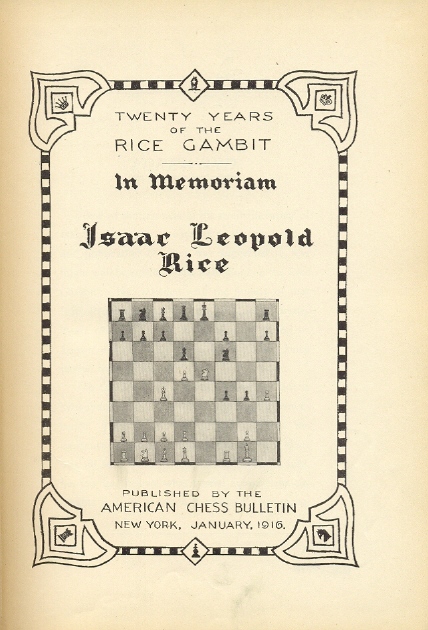 Not that he had much time for writing. Rice
won his first major legal case, on behalf of the bondholders of the
Brooklyn Elevated Railway, by reorganizing the company to conform to
municipal regulations, and he became fascinated by electrical power in
the process. Asked to restructure the ailing St. Louis and Southwestern
Railway, a line whose tracks, he said, looked like the Atlantic in a
gale, he did the job so swiftly that the Texas Pacific Railroad also
requested his services. His clients and colleagues found the polished
attorney eccentric but energetic, witty but calculating. His “electric”
personality inspired trust but not warmth. His reserve disappeared with
his children, who adored him, and with chess players, who thought of
him as the father of organized American chess. Not that he had much time for writing. Rice
won his first major legal case, on behalf of the bondholders of the
Brooklyn Elevated Railway, by reorganizing the company to conform to
municipal regulations, and he became fascinated by electrical power in
the process. Asked to restructure the ailing St. Louis and Southwestern
Railway, a line whose tracks, he said, looked like the Atlantic in a
gale, he did the job so swiftly that the Texas Pacific Railroad also
requested his services. His clients and colleagues found the polished
attorney eccentric but energetic, witty but calculating. His “electric”
personality inspired trust but not warmth. His reserve disappeared with
his children, who adored him, and with chess players, who thought of
him as the father of organized American chess.
Every year, Isaac Rice played chess
against
“athletes of the intellect,” as he referred to his opponents, at
Simpson’s in London or the Café de la Régence in Paris.
Perhaps the
ease with which he did so many other things made the challenges of
chess addictive. In 1895, his obsession ignited by the energy spilling
over from his patent battles, he invented the Rice gambit, a variation
on the Kieseritzky gambit. Not a ploy for beginners, the dangerous
strategy called for white to sacrifice a knight. Clearly he based his
hopes for immortality upon its success, and boldly he urged formal
trials of its validity. As his wealth grew, he furnished trophies for
American players and financed chess tournaments in the world’s major
cities.
That wealth swelled with his growing
entrepreneurship. On September 7,
1896, in the first auto race on a
track held in America, at Narragansett Park, Rhode Island, two electric
automobiles—traveling at an average speed of twenty-five miles per
hour—sped past three gasoline-powered Duryeas. One of the two was the
Electrobat, built by Henry G. Morris and Pedro G. Salom, two inventors
from Philadelphia. The next year Morris and Salom put thirteen of their
electric hansoms on the streets of Manhattan—the first automotive
taxicab fleet in the United States. The battery king quickly bought
their Electric Carriage and Wagon Company. The new president changed
the name to the Electric Vehicle Company, drew up a contract
guaranteeing a discount on batteries from the Electric Storage Battery
Company, built another eighty-seven Electrobats, and streamlined
service to the public.
The
electric taxis were a sensation. Quiet
and comfortable if not speedy (ten miles per hour), they could carry
passengers for about twenty miles between charges. When the batteries
ran low, the driver wheeled into one of ten stations spotted around
Manhattan. Inside the garage a hydraulic lift removed the entire
nine-hundred-pound array of chloride accumulators from under the
chassis and replaced them with freshly charged cells. The cab was back
on the street in minutes. Unable to lessen a weight that frequently
crushed the wheels, Rice took over the Consolidated Rubber Tire
Company, maker of Kelly tires, to ensure a cheap supply. Rice dubbed
the blue-coated drivers “lightning cabbies” in honor of the electricity
that propelled them.
Unfortunately
Rice’s success attracted
unwanted attention of a different kind. The speculators Thomas F. Ryan
and William C. Whitney, who controlled a near-monopoly on surface
transit in New York, bought the Pope Automobile Company, also a maker
of electrics. Envious of Rice’s battery monopoly, Ryan and Whitney
mounted a proxy fight for control of the Electric Storage Battery
Company. In 1899, when resistance became pointless, Rice sold most of
his holdings in the company for several million dollars. He may have
known that Thomas Edison, confident that he could build a light-weight
car battery, was about to start work on his alkaline cell.
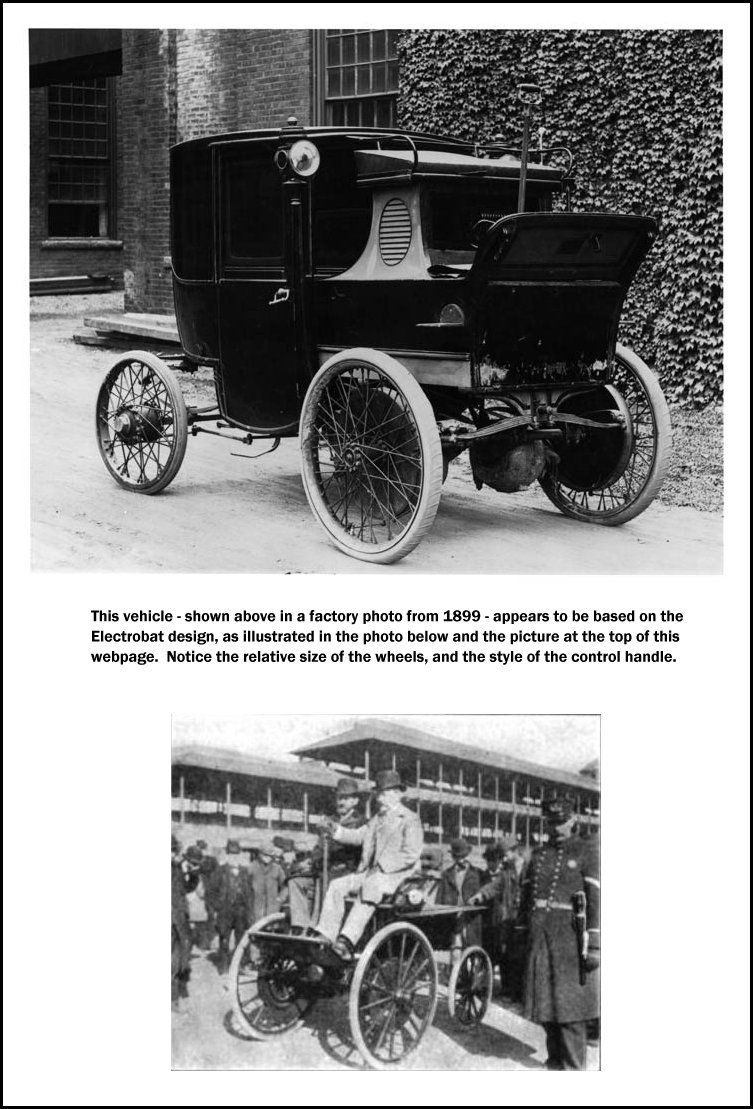
In
taking over the battery company, Ryan and
Whitney discovered that it was contractually obligated to supply
batteries at cost to the Electric Vehicle Company, a favored
relationship that undermined their plans for the Pope company. When
they refused to honor the contract, Rice threatened litigation. The
impasse ended with Ryan and Whitney buying the Electric Vehicle Company
for an additional two million dollars. Ryan and Whitney soon bought the
rights to the Seiden gasoline engine and thus achieved for the Electric
Vehicle Company the patent monopoly over American automobile
manufacture that Rice had lacked time to build. (Henry Ford broke the
monopoly in 1911.) Having accepted the sacrifice of his
two
largest
companies, Rice checkmated his opponents by announcing that he had just
bought William Griscom’s “master patent” on electric drive trains, that
it probably applied to both electric automobiles and electric trams,
and that he was prepared to destroy their companies should they try
more proxy maneuvers. He had reason to think that William Whitney, a
former secretary of the Navy in Cleveland’s first cabinet, had his eye
on Rice’s real queen: the world’s most advanced submarine.
Julia Rice, by now a national advocate
of a
“safe and sane Fourth of July,” probably did not know that her
dignified husband spent July 4, 1899, submerged in six fathoms of water
about three thousand yards from the Statue of Liberty. Invited to sail
in the Holland by the Holland Torpedo Boat
Company, a nearly bankrupt customer for storage batteries, Rice
resurfaced as a convert to submarines. With characteristic speed the
entrepreneur incorporated the Electric Boat Company. This time, to ward
off speculators, he encouraged capital from respectable bankers like
the Rothschilds. Electric Boat purchased Holland’s firm and then two
other companies—the Electro-Dynamic Company of Philadelphia,
manufacturers of fine electric motors, and the Electric Launch Company
of Bayonne, New Jersey, makers of luxury yachts. Over the years, Rice
added the Industrial Oxygen Company, to supply compressed air, the
National Torpedo Company, to furnish weapons, and three research and
development corporations, to amass six hundred mechanical, marine, and
armament innovations. With these key patents he was to dominate the
submarine industry.
When Rice bought John P. Holland’s
submarine, it was already superior to all others because of five
features. Unlike European subs, the Holland
was truly buoyant even with its ballast tanks flooded; moreover, it was
stable underwater, circulated its own air instead of relying on
snorkels, and was powered by dual motors: a gasoline model for surface
cruising and a fume-free electric plant for underwater running. Most
important, it free-dived like a porpoise. The submarine built by Simon
Lake, Holland’s only significant American competitor, simply sank on an
even keel to the bottom, where it trundled about on wheels. In 1895 the
Navy had insisted that Holland build the Plunger,
a steam-powered submarine of impractical design. Disappointed with the
result, the Navy now refused to buy the Holland.
Holland claimed that naval officers
disliked
the submarines because they had no decks to strut on, but their
reluctance actually stemmed from a traditional preference for
battleships, an understandable fear that underwater vessels were
dangerous, and a simple lack of imagination. To put public pressure on
the Navy, Rice used the tactics of the entrepreneur. He ordered a crew
to sail the Holland from Brooklyn down the
Intracoastal Waterway to Washington and once there to advertise
exhibitions just offshore in the Potomac River. The Navy bought the Holland
on April 11, 1900. Lobbying hard before appropriations committees, Rice
secured contracts for seven more boats in 1901 and for another four in
1905.
Although the Spanish-American War had
convinced Congress that the United States was now a world military
power, the government had not yet adopted the military spending
patterns of future decades. Knowing that his only additional customers
would be sovereign nations, Rice turned Electric Boat into America’s
major international arms dealer. He sold five boats outright to Japan
in 1904 but preferred “working arrangements” with foreign companies.
Traveling four months every year, he licensed patents and furnished the
plans to the Société Française de Sous-Marine, for
France; to the
Nevski Works, for Russia; to the Emprezia Dimprairo Industrial
Portugueza, for Portugal; to De Scheide, for the Netherlands; to the
Whitehead Torpedo Company, for Austro-Hungary; to Deutsche Parsons
Turbionia and to Krupp, for Germany; and to Vickers Sons and Maxim, for
Britain. The agreements were masterpieces of cunning, with features,
Rice admitted, that were “unique in patent experience.” The licensees
put up all the capital and returned part of the proceeds at no risk to
the Americans. For example, Electric Boat received two-thirds of the
net receipts on any submarine Vickers sold for a specified period and
half for any sold thereafter—even if the British shipyard made the
vessel to a different design. Rice had created a market where there was
none.
When the first British submarine
nearly
turned turtle, rumors spread that Holland, an Irish Republican
sympathizer, had deliberately botched his own drawings. While not true,
the story alluded to Holland’s discontent, the result of a classic
collision between genius and commerce. Holland had built submarines
since 1878, each more wonderful than the one before, had done so
despite insolvency and ridicule, and now was unhappy that he could not
experiment at will. Rice was not sympathetic, perhaps because neither
he nor those whose patents he had bought had been emotionally involved
with the inventions he promoted. Paradoxically, the less complex
battery had been a more collective effort; the submarine was the child
principally of one man. Friction was bound to develop between an
inventor who most wanted to perfect his boat and the corporation that
most wanted to sell the model it had. For his part, Rice pointed out
that Holland could not build a submarine by himself and implied that if
the submarine was the engineer’s invention, then Electric Boat was
Rice’s. Still, there was something shabby about Holland’s salary, only
ninety dollars a week, and the mere fifty thousand dollars he had been
paid for his patents. When Holland resigned from Electric Boat in 1904,
Rice for some years after thwarted the inventor’s efforts to construct
new submarines, on the ground that Holland was infringing on patents
now held by the company.
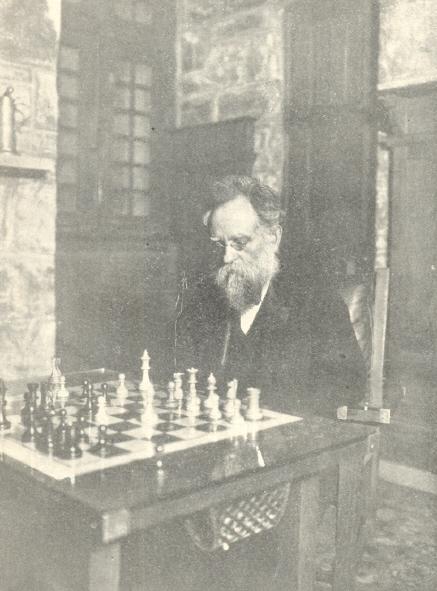 Rice’s energy surged on into the new
century. Excited by the discovery that casein, a milk product, could be
used for paints, paper sizing, and glue, he founded the Casein Company
of America and then incorporated his usual cognate industries. He built
on Riverside Drive in New York City a mansion lavish enough for a
robber baron. Unlike those less sophisticated tycoons, however, he
actually played the piano in the music room, and he spent days in the
chess room blasted out of rock beneath the house. There he refined the
Rice gambit and sponsored local tournaments on his gorgeous tables. J.
P. Morgan merely purchased his art; Rice lived his. Rice’s energy surged on into the new
century. Excited by the discovery that casein, a milk product, could be
used for paints, paper sizing, and glue, he founded the Casein Company
of America and then incorporated his usual cognate industries. He built
on Riverside Drive in New York City a mansion lavish enough for a
robber baron. Unlike those less sophisticated tycoons, however, he
actually played the piano in the music room, and he spent days in the
chess room blasted out of rock beneath the house. There he refined the
Rice gambit and sponsored local tournaments on his gorgeous tables. J.
P. Morgan merely purchased his art; Rice lived his.
But Electric Boat was faltering, kept
alive
only by the foreign licenses. The American Navy was in no hurry to
expand its fleet, and overseas competition had eaten into the foreign
market. The 54-foot, 73-ton Holland had
metamorphosed into the 105-foot, 180-ton Octopus,
whose screws drove it at 11 knots on the surface and whose hull
permitted dives of 200 feet. Development and construction cost more
than the price it brought. Rice, moreover, was a better entrepreneur
than corporate executive. Excited by the future, he sometimes neglected
the technologies of the present. The financial panic of 1907 increased
Electric Boat’s short-falls and eroded its lines of credit. Rice
covered debts with his own millions, siphoned funds from his profitable
companies, and, against his principles, borrowed more from Vickers. To
add to the company’s troubles, the House of Representatives in 1908
opened hearings to investigate charges that representatives of Electric
Boat had paid off members of Congress, journalists, and naval officers
in a successful bid for seven submarines in 1907. As in most such
cases, the smoke probably indicated some fire, but the committee
decided, after weeks of testimony, that the unproved accusations had
originated with the Lake Torpedo Boat Company, angered that the Navy
had once aeain rejected its submarine.
Aware that newspaper cartoons depicted
Electric Boat as a shark, Rice as a witness seemed exasperated: “You
see I may control the President of the United States and Congress, but
it is really asking too much that I should control all the parliaments
of the entire world.” He managed nevertheless to conceal the fact that
Vickers, a foreign company, now owned a large fraction of one of
America’s biggest defense contractors. The other notable feature of his
testimony was the pride he displayed in his role as an entrepreneur. He
was not really a promoter, he said, or just a corporate head; he
founded whole industries.
Rice took the hearings in stride; he
was a
veteran witness at commissions. But the bankers’ panic of 1907 had
strained his companies and wiped out large personal assets. Feeling
pinched, he sold his house on Riverside Drive for less than it had
cost. That was not entirely to be regretted, for the place had become
uncomfortable. Julia Rice, now head of the Society for the Suppression
of Unnecessary Noise, had campaigned against the ebullient tooting and
whistling that accompanied water traffic in New York Harbor. As a
consequence, every night vessels passing on the Hudson River aimed
their searchlights at the Rice mansion, then let loose with sirens,
horns, and klaxons. (The redoubtable Mrs. Rice was not to be
intimidated; every quiet school zone or hospital zone in America owes
its existence to her.) After 1908 the family headquarters was a large
suite at the Ansonia Hotel, a splendid building still standing at
Seventy-third Street and Broadway.
There the Rices lived quietly,
devoting
themselves to cultural affairs like the Poetry Society of America,
which began in their apartment, and, somewhat ironically, considering
the armaments business, the Peace Society. Although Rice did not lose
any of his companies, Electric Boat remained shaky. Its stock drifted
down to ten dollars a share. Selling a submarine was not like selling a
battery; it was not a versatile technology, adaptable to other uses.
Tired, Rice lost interest in innovation. When Westinghouse won the 1911
patent suit over the interpole motor, into whose development he had
poured $145,000, Rice refused to finance a new diesel engine, so his
employees paid for it themselves.
Rice’s momentum had slowed, but his
faith in
the submarine was about to be vindicated. He traveled to St. Petersburg
on business just before Europe erupted, and was taken seriously ill
while in Russia. He was still recuperating back at the Ansonia on
September 22, 1914, when the U-9 torpedoed and sank the British
cruisers Aboukir, Cressy,
and Hogue
off the Dutch coast. The U-boats, although a considerable departure
from the original patents Rice had licensed to Germany, were still
essentially Holland’s invention. In November the British admiralty sent
an emergency order to Electric Boat for twenty submarines. The market
Rice had carefully built suddenly boomed.
Rice arranged to have the vessels
transshipped through Canada to avoid America’s neutrality restrictions
and then, because of his illness, stepped down as president of Electric
Boat. As the company’s stock soared, he sold twenty-eight thousand
shares for about three and a half million dollars. Had he waited
another three months, as his obituaries pointed out, he could have
realized sixteen million. He died on November 2, 1915, before Germany’s
policy of unrestricted submarine warfare brought the United States into
the conflict.
The great economist Joseph Schumpeter
might
have used Rice’s career to illustrate his thesis that innovative
capitalists revise both the technologies of their times and their very
cultures. The entrepreneur not only adapts inventions to fit the
demands of his time but also alters demand itself. He does not rely on
the “invisible hand” of classical competition; he intervenes. Rice’s
interventions were memorable. His most obvious achievement was to
reconfigure the navies of the world. Less visibly he pioneered patent
law and fostered literature, music, and chess. Brief as his sojourn in
the young automobile industry was, it confirmed his entrepreneur’s
instinct for the important. His batteries powered machines that changed
the domestic and social lives of his fellows. Although his method was
monopoly, he democratized technology by making it cheap and available.
In so doing, he stimulated other inventions and engineered growth
across a broad range. Most lastingly, he invented business structures
that affect Americans today. He can still stand as a model for the
American entrepreneur.
The Rice gambit never achieved the
fame its
inventor hoped for, but a corporation, as Daniel Boorstin has remarked,
is potentially immortal. In 1952, in a reorganization Rice would have
applauded, Electric Boat, Electric Launch, and Electro-Dynamics became
General Dynamics. The corporation’s Trident submarines, F-16 fighters,
and Atlas missiles are Rice’s monuments. There is one other memorial.
After her husband’s death Julia Rice gave money for an elaborate sports
complex to be built in his honor in New York City’s Pelham Bay Park.
With an odd sense of homage, the city fathers renamed the streets
around the park Watt, Ohm, and Ampere in recognition of Rice’s
contributions to the electrical industry. Only the concrete shell of
the Isaac Leopold Rice Memorial Stadium stands now, but in its shadow
neighborhood kids still play a little chess.
Invention & Technology Magazine Spring
1987 Volume 2, Issue 3
|




